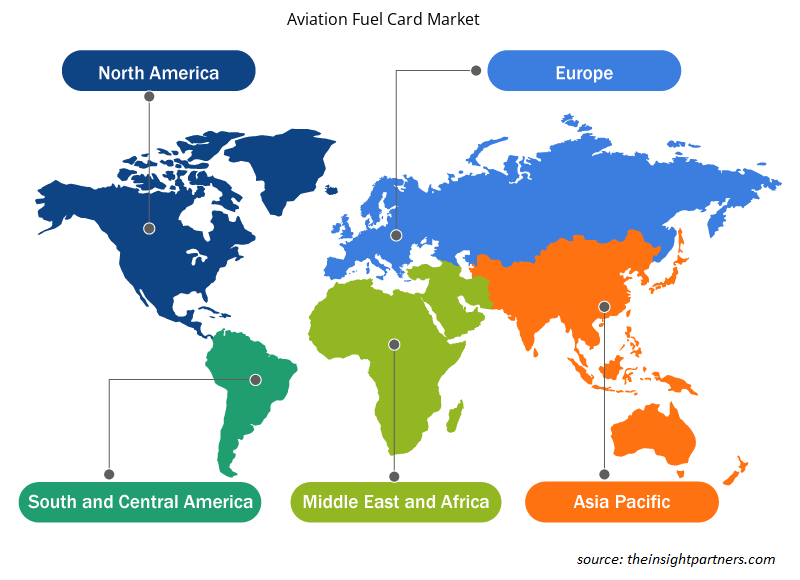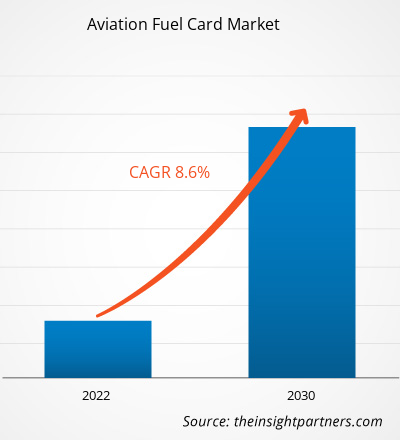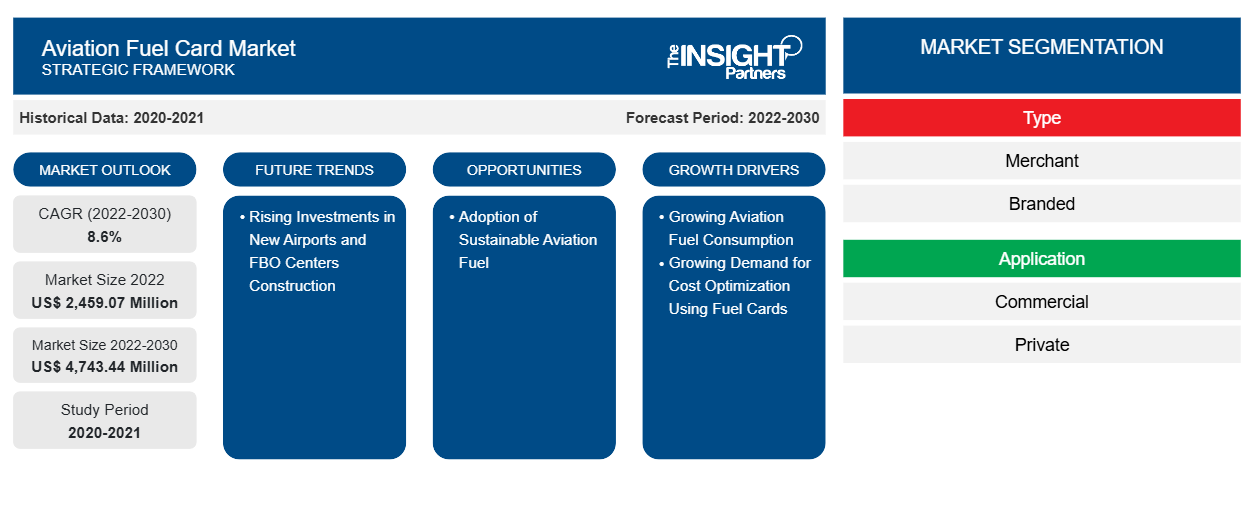항공 연료 카드 시장 규모는 2022년 2,459.07백만 달러에서 2030년까지 4,743.44백만 달러에 도달할 것으로 예상됩니다. 이 시장은 2022~2030년에 8.6%의 CAGR을 기록할 것으로 예상됩니다.
전통적으로 항공 산업은 연료 산업과 항공사의 경제 상황 및 존재하는 계약에 따라 다양한 방식으로 연료에 대한 지불을 했습니다. 항공사와 다른 항공 산업은 종종 석유 회사에서 직접 또는 연료 브로커를 통해 현물 시장에서 연료를 구매합니다. 이러한 상황에서 항공 회사는 현금과 신용을 혼합하여 연료 비용을 지불할 가능성이 가장 높습니다. 전반적으로 항공 산업이 연료를 취득하는 데 사용하는 지불 방법은 회사의 규모, 위치, 구매 전략, 시장 상황 및 사용 가능한 가능성과 같은 다양한 기준에 따라 결정됩니다. 통합 비용 관리 소프트웨어가 있는 고액 기업 카드를 사용하면 연료 지불을 훨씬 더 쉽게 모니터링할 수 있습니다. 고액 카드를 사용하면 기업이 훨씬 더 많은 지불 유연성을 얻을 수 있으므로 은행 지연 및 대출 수수료 없이 계속 운영할 수 있습니다. 또한 비용 관리 소프트웨어와 거의 연결되지 않는 가솔린 카드와 달리 지출 관리 회사의 고액 기업 신용 카드는 완전히 통합된 경험을 제공합니다. 기업 신용 카드를 사용하면 연료 청구서를 중앙 집중화하고 전반적인 비용 관리 프로세스를 간소화하는 것이 간단해졌습니다. 다양한 결제 방법이나 환불에 의존하는 대신, 모든 연료 관련 구매에 단일 신용 카드를 사용할 수 있어 지출을 추적하고 관리하기가 더 쉬워집니다. 비즈니스 신용 카드로 연료 지출을 통합하면 연료 공급업체와 더 강력한 관계를 구축하는 데 도움이 될 수 있습니다. 연료 거래에 단일 카드를 자주 사용하는 항공 회사는 볼륨 할인 또는 유리한 조건 측면에서 연료 공급업체와 더 많은 협상력을 가질 수 있습니다. 따라서 다른 대체 방법이 제공하는 이점은 항공 연료 카드 시장 성장을 방해합니다.
항공 연료 카드 시장 분석
많은 연료 생산자와 항공사 운영자가 지속 가능한 항공 연료를 개발하고 채택하기 위한 이니셔티브를 취하고 있습니다. 2023년 두바이 에어쇼에서 Boeing과 Zero Petroleum의 임원은 합성 지속 가능한 항공 연료(SAF) 개발을 가속화하기 위한 계약에 서명했습니다. 2023년 Neste는 Trollhättan-Vänersborg 공항과 항공사 Västflyg가 모든 항공편에서 지속 가능한 항공 연료를 사용하는 세계 최초의 항공사가 되도록 지원했습니다. 2023년 Emirates는 Shell Aviation과의 파트너십을 통해 두바이(DXB)에 있는 항공사의 국제 허브에 약 300,000갤런의 혼합 지속 가능한 항공 연료(SAF)를 공급하기로 합의했습니다. 이러한 이니셔티브는 지속 가능한 항공 연료의 채택을 늘릴 것으로 예상됩니다. 항공 연료 카드 공급업체는 지속 가능한 항공 연료 구매에 대한 매력적인 혜택과 할인을 제공하여 사업을 확장할 수 있습니다. 이는 궁극적으로 항공 연료 카드의 채택과 사용 증가로 이어질 것입니다. 또한 고정 기반 운영자와의 파트너십을 통해 연료 카드 서비스 제공자는 지속 가능한 항공 연료를 공급하기 위한 네트워크를 확장할 수 있습니다. 따라서 지속 가능한 항공 연료 거래의 증가는 예측 기간 동안 항공 연료 카드 시장 성장에 충분한 기회를 제공할 것으로 예상됩니다.
항공 연료 카드 시장 개요
항공 연료 카드 시장 생태계에서 연료 카드 공급업체의 역할은 연료 카드의 원활한 기능과 신뢰성을 보장하는 데 중요합니다. 항공 연료 카드 공급업체는 상업 및 민간 항공사와 같은 최종 사용자에게 연료 카드 서비스를 제공하는 데 중요한 역할을 합니다. 연료 카드 공급업체는 항공 연료에 대한 지불 프로세스에서 안전하고 효율적인 역할을 보장합니다. 연료 카드 서비스를 제공하는 주요 연료 공급업체는 BP plc, Shell Global, ExxonMobil, Titan Aviation Fuels, Jio-BP, AEGFUELS, TotalEnergies Aviation을 포함한 브랜드 연료 공급업체로 불립니다. 이러한 기관은 항공 연료 및 항공 연료 카드를 스스로 공급하여 신뢰할 수 있는 항공 연료 카드 공급망을 보장할 책임이 있습니다. 연료 카드 서비스를 제공하는 제3자 및 민간 기업은 World Fuel Services, CSI global-fleet, Aviation Pros, Avfuel Corporation을 포함한 상인 연료 공급업체로 불립니다. 상인 연료 카드 공급업체는 주요 항공 연료 공급업체와 파트너십 또는 협업을 맺고 원활하고 안전한 지불 프로세스를 보장하는 기관입니다. 이러한 파트너십이나 협력에는 효율적인 거래를 촉진하고 안정적인 연료 공급을 유지하기 위한 시스템을 통합하는 것이 포함됩니다.
귀하의 요구 사항에 맞게 이 보고서를 사용자 정의하세요
이 보고서의 일부 또는 국가 수준 분석, Excel 데이터 팩을 포함하여 모든 보고서에 대한 사용자 정의를 무료로 받을 수 있으며 신생 기업 및 대학을 위한 훌륭한 혜택과 할인 혜택을 이용할 수 있습니다.
-
이 보고서의 주요 시장 동향을 알아보세요.이 무료 샘플에는 시장 동향부터 추정 및 예측까지 다양한 데이터 분석이 포함됩니다.
항공 연료 카드 시장 동인 및 기회
항공 연료 소비 증가
항공 여행에 대한 수요가 높아 전체 연료 소비가 증가했습니다. 2022년에 미국 항공사는 2021년보다 1억 9,400만 명 더 많은 승객을 수송했으며, 이는 전년 대비 30% 증가한 수치입니다. 2022년 1월부터 12월까지 미국 항공사는 8억 5,300만 명의 승객을 처리했으며, 이는 2021년의 6억 5,800만 명, 2020년의 3억 8,800만 명에서 증가한 수치입니다. 2021년에 유럽 연합(EU)은 총 승객 수가 3억 7,300만 명에 도달하면서 항공 여행이 상당히 회복되었습니다. 이 수치는 전년인 2020년에 비해 34.9% 증가한 수치입니다. 항공 승객 수의 급증은 크로아티아에서 관찰되었으며, 2021년에 비해 84%라는 놀라운 증가를 경험했습니다. 또한 키프로스와 그리스는 각각 104.8%와 85.9%의 상당한 성장률을 기록했습니다. 특히 크로아티아, 키프로스, 그리스 등의 국가에서 승객 수의 급증은 항공 여행에 대한 수요가 증가하고 있으며, 이에 따라 연료에 대한 필요성이 커지고 있음을 보여줍니다.
신공항 및 고정 기지 운영자 센터 건설에 대한 투자 증가
전 세계의 다양한 선진국과 개발도상국은 공항의 총 수를 늘리는 데 주력하고 있습니다. 2023년 베트남 정부는 관광과 무역을 강화하기 위해 2030년까지 30개 이상의 공항을 건설할 계획입니다. 이 나라는 22개의 공항을 건설했지만, 정부는 증가하는 항공기 수를 수용하기 위해 새로운 공항을 건설하는 데 주력하고 있습니다. 베트남 정부는 2021년에 롱탄 국제공항 건설을 승인했으며, 2025년에 완공될 예정입니다. 롱탄 국제공항은 베트남 최대 규모의 공항으로, 연간 최대 1억 명을 수용할 수 있습니다. 정부는 2030년까지 30개 이상의 공항으로 확장할 계획이며, 이는 항공 산업 개발에 대한 베트남의 의지를 보여줍니다. 2023년 사우디아라비아는 국내 항공 산업 확장을 발표했으며, 여기에는 1,000억 달러의 투자가 필요합니다. 인도는 2023년에 향후 2년간 공항에 120억 달러를 투자한다고 발표했는데, 여기에는 급증하는 여행 수요를 충족하기 위해 수백 대의 신형 항공기 주문이 포함되어 있어 현재 인프라에 부담을 주고 있습니다.
항공 연료 카드 시장 보고서 세분화 분석
항공 연료 카드 시장 분석에 기여한 주요 세그먼트는 유형, 응용 프로그램 및 지역입니다.
- 유형에 따라 항공 연료 카드 시장은 상인 및 브랜드로 세분화되었습니다. 상인 세그먼트는 2022년에 더 큰 시장 점유율을 차지했습니다.
- 항공 연료 카드 시장은 응용 프로그램별로 상업용과 민간용으로 세분화되었습니다. 상업용 세그먼트는 2022년에 시장에서 가장 큰 점유율을 차지했습니다.
지역별 항공 연료 카드 시장 점유율 분석
항공 연료 카드 시장 보고서의 지리적 범위는 주로 북미, 유럽, 아시아 태평양, 중동 및 아프리카, 남미의 5개 지역으로 나뉩니다.
북미는 2022년 항공 연료 카드 시장을 지배했으며, 예측 기간 동안에도 지배력을 유지할 것으로 예상됩니다. 북미 항공 연료 카드 산업은 주로 연료 카드 개념에 대한 인식 증가에 의해 주도됩니다. 게다가, 미국과 캐나다와 같은 국가에서 성장하는 항공 산업은 항공 연료 카드 시장을 더욱 촉진하고 있습니다. 항공 산업은 미국에서 주목할 만한 산업 중 하나입니다. Airlines for America가 2023년에 발표한 데이터에 따르면, 상업 항공은 2022년에 미국 GDP의 5%와 1조 2,500억 달러를 차지했습니다. 게다가, 미국 내 대규모 공항 및 고정 기지 운영자 네트워크는 항공 연료 카드 사용 증가를 지원했습니다. 2022년에 미국은 5,100개 이상의 공공 공항과 14,850개의 민간 공항을 운영했습니다. 항공 운송 산업은 캐나다 경제에 상당히 기여합니다. 국제항공운송협회(IATA)에 따르면, 이 산업은 2018년 캐나다 GDP에 370억 달러를 기여했습니다. 항공 연료 소비 증가와 항공 가격 상승이 멕시코의 항공 연료 카드 시장을 주도하고 있습니다. 2022년 6월, 국영 Pemex의 도매 제트 연료 가격이 극적으로 상승했습니다. 미국은 2022년 북미 항공 연료 카드 시장에서 가장 큰 점유율을 차지했습니다.
항공 연료 카드 시장 지역 통찰력
Insight Partners의 분석가들은 예측 기간 동안 항공 연료 카드 시장에 영향을 미치는 지역적 추세와 요인을 철저히 설명했습니다. 이 섹션에서는 북미, 유럽, 아시아 태평양, 중동 및 아프리카, 남미 및 중미의 항공 연료 카드 시장 세그먼트와 지리에 대해서도 설명합니다.

- 항공 연료 카드 시장에 대한 지역별 데이터 얻기
항공 연료 카드 시장 보고서 범위
| 보고서 속성 | 세부 |
|---|---|
| 2022년 시장 규모 | 2,459.07백만 달러 |
| 2030년까지 시장 규모 | 4,743.44백만 달러 |
| 글로벌 CAGR (2022-2030) | 8.6% |
| 역사적 데이터 | 2020-2021 |
| 예측 기간 | 2022-2030 |
| 다루는 세그먼트 |
유형별로
|
| 포함된 지역 및 국가 |
북아메리카
|
| 시장 선도 기업 및 주요 회사 프로필 |
|
항공 연료 카드 시장 참여자 밀도: 비즈니스 역학에 미치는 영향 이해
항공 연료 카드 시장은 소비자 선호도의 변화, 기술 발전, 제품의 이점에 대한 인식 증가와 같은 요인으로 인해 최종 사용자 수요가 증가함에 따라 빠르게 성장하고 있습니다. 수요가 증가함에 따라 기업은 제품을 확장하고, 소비자의 요구를 충족하기 위해 혁신하고, 새로운 트렌드를 활용하여 시장 성장을 더욱 촉진하고 있습니다.
시장 참여자 밀도는 특정 시장이나 산업 내에서 운영되는 회사나 기업의 분포를 말합니다. 주어진 시장 공간에 얼마나 많은 경쟁자(시장 참여자)가 존재하는지 그 규모나 총 시장 가치에 비해 나타냅니다.
항공 연료 카드 시장에서 운영되는 주요 회사는 다음과 같습니다.
- 쉘 주식회사
- BP 주식회사
- 연합 에너지 그룹 LLC
- 비바 에너지 그룹 유한회사
- TITAN 항공연료 주식회사
면책 조항 : 위에 나열된 회사는 어떤 특별한 순서에 따라 순위가 매겨지지 않았습니다.

- 항공 연료 카드 시장 주요 주요 업체 개요를 알아보세요
항공 연료 카드 시장 뉴스 및 최근 개발
항공 연료 카드 시장은 1차 및 2차 조사 이후의 질적, 양적 데이터를 수집하여 평가합니다. 여기에는 중요한 기업 간행물, 협회 데이터 및 데이터베이스가 포함됩니다. 다음은 항공 연료 카드 시장과 전략에 대한 시장의 개발 목록입니다.
- 2023년 9월, 국제 항공 연료 제품 및 서비스 공급업체인 Air bp는 ExecuJet과 새로 합의한 대리점 협업을 통해 베를린 브란덴부르크 공항(BER)의 General Aviation(GA) 터미널에서 Jet-A1 연료를 제공하기 시작했습니다. (출처: Air BP, 보도자료/회사 웹사이트/뉴스레터)
- 2022년 10월, 글로벌 B2B 지불 및 송장 네트워크인 TreviPay는 KHI가 지원하는 TreviPay Aviation Network를 출시하여 일반 및 방위 항공 산업에 서비스를 제공하는 FBO(고정 기지 운영자) 및 비행 지원 서비스 기관과 고객의 요구에 맞춰 공동 브랜드화된 폐쇄 루프 카드 솔루션을 제공했습니다. (출처: TreviPay, 보도 자료/회사 웹사이트/뉴스레터)
항공 연료 카드 시장 보고서 범위 및 제공물
"항공 연료 카드 시장 규모 및 예측(2020-2030)" 보고서는 아래 영역을 포괄하는 시장에 대한 자세한 분석을 제공합니다.
- 범위에 포함된 모든 주요 시장 세그먼트에 대한 글로벌, 지역 및 국가 수준의 시장 규모 및 예측
- 동인, 제약 및 주요 기회와 같은 시장 역학
- 주요 미래 트렌드
- 포터의 5가지 힘에 대한 자세한 분석
- 주요 시장 동향, 주요 업체, 규정 및 최근 시장 동향을 포괄하는 글로벌 및 지역 시장 분석
- 시장 집중도, 히트맵 분석, 유명 기업 및 최근 개발 사항을 포함하는 산업 환경 및 경쟁 분석
- SWOT 분석을 통한 자세한 회사 프로필
- 과거 분석(2년), 기준 연도, CAGR을 포함한 예측(7년)
- PEST 및 SWOT 분석
- 시장 규모 가치/거래량 - 글로벌, 지역, 국가
- 산업 및 경쟁 환경
- Excel 데이터세트
최근 보고서
사용 후기
구매 이유
- 정보에 기반한 의사 결정
- 시장 역학 이해
- 경쟁 분석
- 고객 인사이트
- 시장 예측
- 위험 완화
- 전략 기획
- 투자 타당성 분석
- 신흥 시장 파악
- 마케팅 전략 강화
- 운영 효율성 향상
- 규제 동향에 발맞춰 대응























 무료 샘플 받기 - 항공 연료 카드 시장
무료 샘플 받기 - 항공 연료 카드 시장